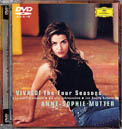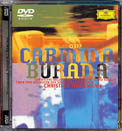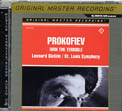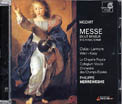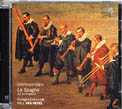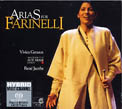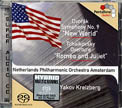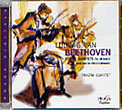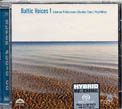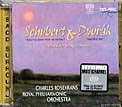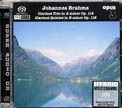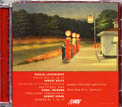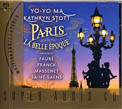|
You are reading the older HTML site Positive Feedback ISSUE 11january/february 2004
Hi-Res reviews featuring our friends from Audiophile Audition, Part 1 Since we dealt with hi-res pop and rock last month, I thought it would be good to devote the reviews selected from AUDIOPHILE AUDITION this time to be all classical. There are starting to be so many releases from so many labels each month that I am considering eventually reviewing just SACD and DVD-A releases exclusively in AUDIOPHILE AUDITION. Some of the most massive series of releases are coming from Concord and Fantasy in the jazz area, and we'll get to some of those next time, as well as some of the oddball "2+2+2" classical DVD-As from MDG & Divox. (Requiring a second pair of frontal speakers located above the present frontal L & R front speakers—fed by the Center and LFE channels.) The rest of our 54 Hi-Res Reviews in the December issue are viewable Right Here John Sunier MULTICHANNEL DISC OF THE MONTH
VIVALDI: The Four Seasons; TARTINI: Sonata in G Minor "Devil’s Trill"—Anne-Sophie Mutter, violin soloist and conductor/Trondheim Soloists—DGG DVD-Audio B0001291-19 Oh yes, yet another Four Seasons, I know. But this one is the best I’ve yet heard in hi-res surround, and it comes with a fascinating video of Mutter and photo gallery. The attractive note booklet also includes the poem/programs for each month which appeared with the original publication of the concertos- thought to have been written by Vivaldi himself. Mutter adopts a very earthy and rustic approach to the violin here which seems influenced by the hell-bent energy of certain performing ensembles of which Il Guardino Armonico immediately comes to mind. However, Mutter has smoothed the rough edges a bit for a refined treatment that still has 100% more emotional communication than your typical Four Seasons performances of, say, a decade ago. Both stereo and surround mixes are just 48K but resolution is clearly more detailed and natural than 44.1 CD. John Sunier A series of chorus & orchestra works on our next hi-res discs...
ORFF: Carmina Burana—Christian Oelze, soprano; David Kuebler, tenor; Simon Keenlyside, baritone; Choir and Orchestra of the German Opera, Berlin, Youth Choir Berlin, Christian Thielemann cond.—DGG DVD-Audio B0001294-19 And also yet another Carmina Burana, but a most worthwhile one. This work requires a certain wild abandon in the solos and choral parts to depict the licentious and hard-drinking exploits of the undisciplined goliards who created these songs and dances. The ancient poems, simple melodies and repetitive rhythms are designed to create a sort of magical and timelss atmosphere. I had an earlier DVD-A release of the work on Teldec with Zubin Mehta conducting; not nearly as exciting as Thielemann’s effort—which we reviewed in CD form in November 1998. I said at that time my only beef was that it was too distantly-miked. Well, now with the surround mix that’s no problem. I predicted the CD might become one of the DGG’s first DVD-A releases. That was a bit premature, but now we have it and it’s good. There are also two versions on Telarc. The earlier Robert Shaw is SoundStream stereo and not as involving as the more recent multichannel SACD with Donald Runnicles and the Atlanta forces. The bass drum at the opening and closing O Fortuna sections is accently completely differently on the two recordings. The Telarc starts softly and builds louder and louder on repeats. The DGG drum is just the opposite. The vocal soloists on the DGG are more specifically located spatially than on the Telarc, but the latter has a somewhat more musical and silky sonic picture. Both maintain exactly the right feeling and excitement. The new disc has nice artwork on the list of tracks but no lyrics on the screen as the Zubin Mehta DVD-A had featured. However, there are translations of the Latin and Low German words in the booklet. John Sunier
PROKOFIEV: Ivan the Terrible—oratorio from the score for the Eisenstein film—St. Louis Symphony/Leonard Slatkin—Mobile Fidelity multichannel SACD UDSACD 4003 Speaking of translations, Mo-Fi missed the boat on this one. There is no libretto or translation of any kind provided, and this is an oratorio. All that appears is a listing of the titles of the 11 parts of the work. It’s a gold SACD, remastered by Paul Stubbelbine from the original tapes made for the Vox/Turnabout label in l979 by Marc Aubort (who wrote the notes for this reissue) and his partner Joanna Nickrenz. What is provided and proves most interesting is details from Aubort about exactly the mics used and a diagram of their locations. The original live performance has a narrator but Slatkin felt that was not appropriate for the recording. The bells which very dramatically peal away in the spectacular finale of the work were recorded separately and mixed in. This work is not nearly as well known as Prokofiev’s Alexander Nevsky. The oratorio is actually more subtle than was the soundtrack music for the film, and relies more on irony—often creating a contrast with what is being seen on the screen. A demonstration-quality surround mix of some very compelling music. John Sunier
MOZART: Mass in C Minor—Oelze/Larmore/Weir/Kooy/La Chapelle Royale Collegium Vocale/Champs Elysees Orchestra/Philippe Herreweghe—Harmonia mundi multichannel SACD HMC 801393 Part of the welcome monthly series of SACD releases from HM, this disc goes on sale December 9th. It is an acclaimed performance of 1992 but was obviously not recorded on multitrack so this is a stereo-only hybrid SACD. As with his Requiem, this mass was left in an unfinished form and completed by others later. It is in a composite style and bears influences both Bach and Handel. As with many of Mozart’s works, there are Free Masonry references, which exist very happily alongside the Catholic mass form and Latin words—even though the two were anathema to one another. Feeding thru ProLogic II I got as naturally enveloping a surround field as most discrete multichannel recordings of this type of music. John Sunier
COSTANZO FESTA (1490-1545): 32 Variations on "La Spagna"—Huelgas-Ensemble/Paul Van Nevel—Harmonia mundi HMC 801799 Multichannel SACD [Also Release Date of December 9th] Long-form works were almost unknown in the Renaissance period when Festa composed his huge cycle of 125 different variations on the simple and popular 37-note tune La Spagna—whose full title would be translated The Basse Dance from Spain. The theme is actually the tenor line of the dance tune which was being used by many musicians as the cantus firmus on which they built their improvisations. Each of the individual Festa variations are called contrapuncti in the score—whose publication was arranged for by the Venetian Senate. Each variations starts with the theme’s first note and ends with its last note and every bar includes at least one note of the tune. In spite of these constant repetitions the work has much diversity and interest. Musicologists compare it to Bach’s Goldberg Variations or the Musical Offering. Festa intended that the cycle could be played on every type of instrument and could also be sung (though only two of the contrapuncti include a text). Van Nevel stuck to the instrumental option and alternates the whole consort (similar timbre in all parts) with the broken consort (mixed instrumental timbres). He chose just 32 of the 125 variations for his 17-piece original instrument ensemble. A fascinating piece of wide interest; this is the sort of early music that easily catches my jaundiced ear. And keeps me awake. While all the instruments are arrayed in the frontal area, the multichannel option greatly increases their clarity and spread across the soundstage vs. the stereo. John Sunier
Arias for Farinelli – Vivica Genaux, Soprano – Akademie Fur Alte Musik Berlin / Ren� Jacobs, Conductor – Harmonia Mundi HMC 801778 – Multichannel Hybrid SACD The CD release of this Harmonia Mundi disc was reviewed here in the July/August 2002 edition. Just to bring you up to speed and in case you haven’t already heard that version: Farinelli was the most famous of the Italian castrati tenors, who sang in Handel’s operas on the London stage in the early to mid 1700’s. Rather than the frequently overdone Handel, the material performed here comes from some of Farinelli’s and Handel’s contemporaries. The castrati had a vocal range that is best approximated nowadays by mezzo-sopranos, and Miss Genaux performs very admirably in the roles taken here. I was excited when I heard that HM had decided to join the SACD camp, and have had high hopes for their SACD releases. This disc does not disappoint, and in my opinion, takes the original recording to the next level. The orchestra’s sound seemed a little thin on the Redbook CD (not unusual for most original instrument groups), and was the original releases’ Achilles heel. On the multichannel SACD, the orchestra’s sound is fully fleshed out, and gives the listener a near-stage perspective, with good ambience and a much more full-bodied orchestra sound contributed by the presence of the surrounds. Miss Geneaux’s singing is beyond reproach here – whereas the original reviewer found this music a bit wearing, with time I’ve found just the opposite – the more I hear this, the more I like it! Anyway, if you’re not really into multichannel, you can always listen to either the stereo SACD or Redbook layers. Very highly recommended, and a good sign of much more to come from Harmonia Mundi in the SACD arena. Tom Gibbs
DVORAK: Symphony No. 9 "From the New World" – TCHAIKOVSKY: "Romeo and Juliet" Overture – Netherlands Philharmonic Orchestra Amsterdam / Yakov Kreizberg, Conductor – PentaTone Classics 5186 019 – Multichannel Hybrid SACD PentaTone’s RQR series of multichannel SACDs have been uniformly acclaimed for their excellence, but their original recordings have been a somewhat mixed bag, unfortunately, with some quibbles either in the performances or interpretations. This is the first of their original orchestral SACDs I’ve had the opportunity to listen to, and even though the choice of Dvorak’s Ninth would seem odd in a world with countless Ninths to choose from, and with several SACDs of the Ninth already available, didn’t seem to make sense. However, the performances here are rock-solid, and the addition of the Romeo and Juliet Overture makes for a nice program. The tempi used throughout the Dvorak Ninth may seem at first rather plodding, especially when compared to the Bernstein or Szell SACDs on Sony (Bernstein freaking blazes through this work!). Repeated listenings, however, gave me much more of an appreciation for the pace at which Yakov Kreizberg takes his forces through the symphony, and gave his approach a validity on par with other’s more rapid traversal of the work’s movements. The playing from the Netherlands Philharmonic Orchestra is nothing short of stunning, with a sweet string tone throughout, and massive bursts of brass and percussion where appropriate. The Romeo and Juliet Overture was an unusual accompaniment, but is played with bravura, and not too syrupy – and fills out the package nicely, rather than giving us a fairly short playing time (like the Bernstein). Choices are tough in this repertory, but you could do much worse than this disc from PentaTone, plus the fact that it’s a hybrid gives you infinitely more playback options. Tom Gibbs
BEETHOVEN: String Quartets Op. 18, Nos. 4 (C minor), 5 (A major) & 1 (F major) – Praz�k Quartet – Praga Digitals multichannel SACD 250 183 (80 mins.) Praga Digitals has launched itself into the SACD era with a number of astonishing hybrid discs that are stretching the medium both musically and sonically. This newest hybrid release again scores on both counts, taking the Praz�k Quartet close to the conclusion of a cycle which, by many accounts including mine, has become the defining standard for recorded Beethoven quartets in the new century. Recorded in the Domovina Studio in Prague, these performances have a striking degree of holographic presence, even when listened to in the standard CD configuration. The intensity of the colors and the unblinking focus on intonation benefit the Quartet, which take all technical challenges in their stride as befits musical servants of Beethoven. Add the stunning amount of inner detail and clarity, and you get sound so vivid that even the occasional rests have a tangible presence and purity to them. The interpretations are not for the faint of heart. They are bold and forceful of character but what they are in search of is not effect for its own sake, but for Beethoven’s soul, as in the extraordinary serenity of the center section of the Minuetto of Number 4, and the dangerous sexuality of the opening of the Andante cantabile (the theme and variations movement) of No. 5. Like the best interpreters, they are unpredictable: While they rush the last movement of Number 4 off its feet, they take the last movement of Number 1 at a more manageable speed. Pierre Barbier’s liner notes, dense with information and provocative insights, complement the performances. By my reckoning, all that’s left in the Praz�k’s cycle are Op. 74, 95 & 130. If things keep up, when they are released, it will be a time for great celebration. Laurence Vittes
Baltic Voices 1 – Estonian Philharmonic Chamber Choir with the Tallinn
Chamber Orchestra / Paul Hillier, Director – Harmonia Mundi HMU 807311 –
Multichannel Hybrid SACD I’ve been listening to this disc almost daily for the last week or so (J. Gordon Holt would not approve); the disc offers a really stimulating mix of the sacred and the profane, and just keeps getting better with every listen. Kreek’s Psalms of David and Hear My Prayer, O Lord by Sandstrom come closest to approaching traditional choral values – everything else here is all over the map stylistically. Works by Rautavaara and Tormis are reminiscent of Ligeti’s Lux Aeterna (made famous in the movie 2001 A Space Odyssey), but fortunately, the vast majority of the music here offers healthy doses of the mystical beauty that seems to permeate so much of the choral compositions from the Baltic region. My reaction to this disc has been somewhat startling to me, especially since I was pretty much underwhelmed by Harmonia Mundi’s first couple of ventures into the SACD format. They seem to have gotten on the right track, and I have several other new HM SACDs I’m really looking forward to listening to. Very, very highly recommended! Tom Gibbs
SCHUBERT: String Quartet in D Minor "Death and the Maiden" (Arr. for string orchestra by MAHLER); DVORAK: String Quartet in F Major "American" (uncredited string orchestra arrangement)—Royal Philharmonic Orchestra/Charles Rosekrans—Multichannel Telarc SACD-60610 The massed sound of strings could be a painful sonic event for early CDs and CD players. Such distortions have been greatly reduced in recent years but string tone remains one of the sticking points of the 44.1K format. No problem with that here—combined with the surrounding spread of discrete 5.0 reproduction, one is bathed in a rich and silky string sound. Arguably some of the intimacy of the original string quartets is lost, but the larger forces are so cleanly reproduced via DSD that any hesitation with the transcriptions on standard CD melt away with the higher resolution format. Most collectors probably have both of these original quartets already, but don’t let that stop you from the different sort of experience to be had with these lovely transformations. John Sunier
BRAHMS: Clarinet Trio in A Minor; Clarinet Quintet in B Minor—Kjell Fag�us, clarinet; Mats Lidstr�m, cello; Bengt Forsberg, piano; string quartet—Opus 3 multichannel SACD CD 22021 In the fourth recording Fageus (who looks a bit like Benny Goodman) has made for the Swedish label he turns to two of the four works by Brahms involving the clarinet. The composer was moved to write all of them due to the inspiration of the outstanding clarinet virtuoso of the day, Richard M�hlfeld. Brahms found the sublime sound of the instrument seemed to fit the beautiful surroundings of his summer stay in the Austrian Alps. The Quintet has some dark colors tied in with the composer being in a despondent state at the time, but also has great power and positive feelings in other sections. The balance of the clarinet with the other instruments and its slight separation from them is excellent—no over-sized licorice stick here as on many big label recordings. The four-channel sound communicates the subtle ambience of the recording space, and the contrast of the first work, recorded without an audience, and the second with a quiet and attentive audience present. John Sunier
ROBERT KURKA: Symphony No. 2; VIRGIL THOMSON: Filling Station ballet; ROBERT HELPS; Concerto No. 2 for Piano and Orchestra; NIKOLAI LOPATNIKOFF: Festival Overture—Albany Sym. Orch./David Alan Miller (Alan Feinberg, piano)—Albany Stereo SACD TROY591 A most listenable concert of American music in hi-res sonics. The Thomson ballet work attracted me to the disc, as I hadn’t heard a recording of it in quite some time. Not many ballets set in a gas station, and Thomson’s pop flavored, ironic score is a kick. I recall seeing the San Francisco Ballet do this one years ago. The disc seems to be listed under the Kurka Symphony which closes its program. Known primarily for his ironic opera The Good Soldier Schweik, the composer died of leukemia at age 35, just into a promising career. His symphony has been described as combining American optimism and big city bustle with Slavic rhetoric. It reminded me of Kurt Weill and occasionally Prokofiev. The Helps Concerto may be the toughest listen of this program; the composer’s teachers were Roger Sessions and Milton Babbitt. It takes some close listening but its not impenetrable, and unlike most piano concertos it ends softly. The Albany Symphony together with Albany Records is carrying on a fine effort to promote new and unknown works, similar to the longtime Louisville Symphony efforts. John Sunier
Yo-Yo Ma & Kathryn Stott—Paris, La Belle �poque = MASSENET; MEDIATION FROM THA�S, FAURE: Sonata in A Major for Violin & Piano; ST.-SAENS: Havanaise; FRANCK: Sonata in A Major for Violin & Piano—Sony Classical Multichannel SACD-Only SS 87287 A fine program of familiar French chamber music from around a century ago, all arranged for the cello by Yo-Yo Ma. Pianist Stott is a very able accompanist and the surround sonics are excellent, though with both instruments just a bit larger than life. The Sonatas in A Major by Faure and Franck are the mainstays of the program, as they have been on many other recordings. Cello fans will of course prefer these versions to the originals for violin, and both pieces conform to the transcriptions exceedingly well. (This is one of the last of the non-hybrid Sony SACDs, whoopee...) John Sunier Reviews reprinted with permission from Audiophile Audition December issue.
|


